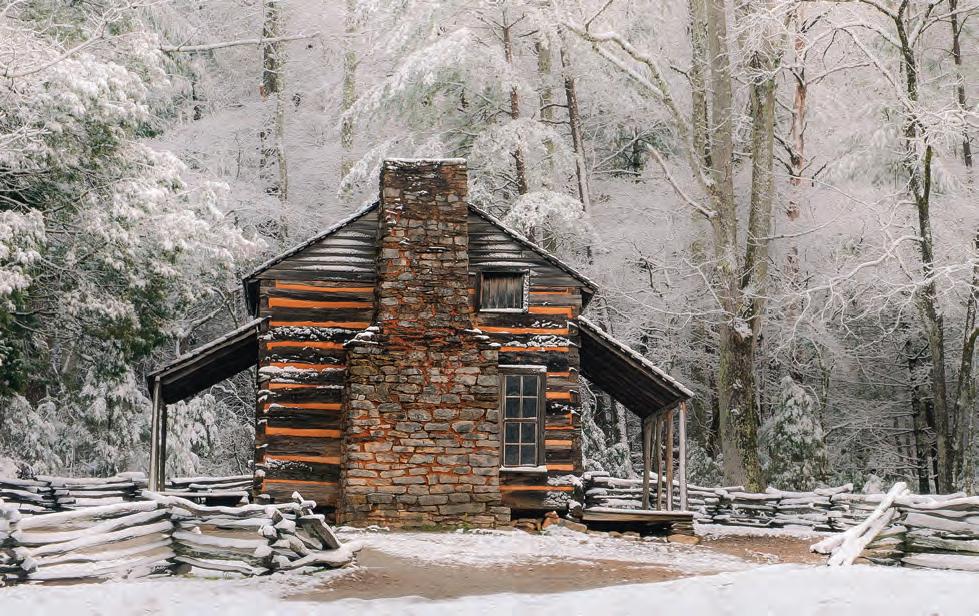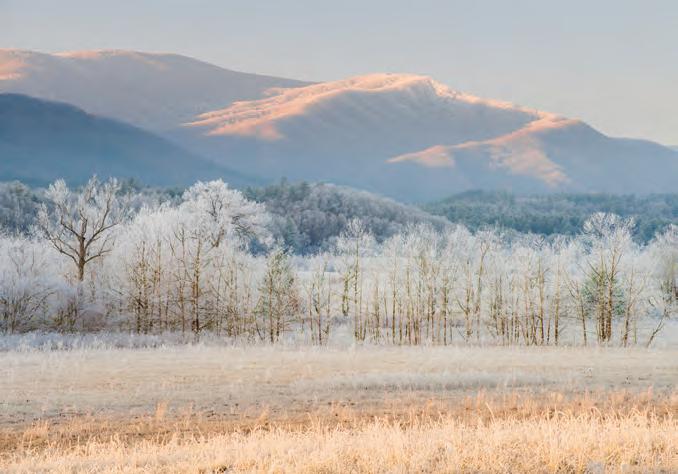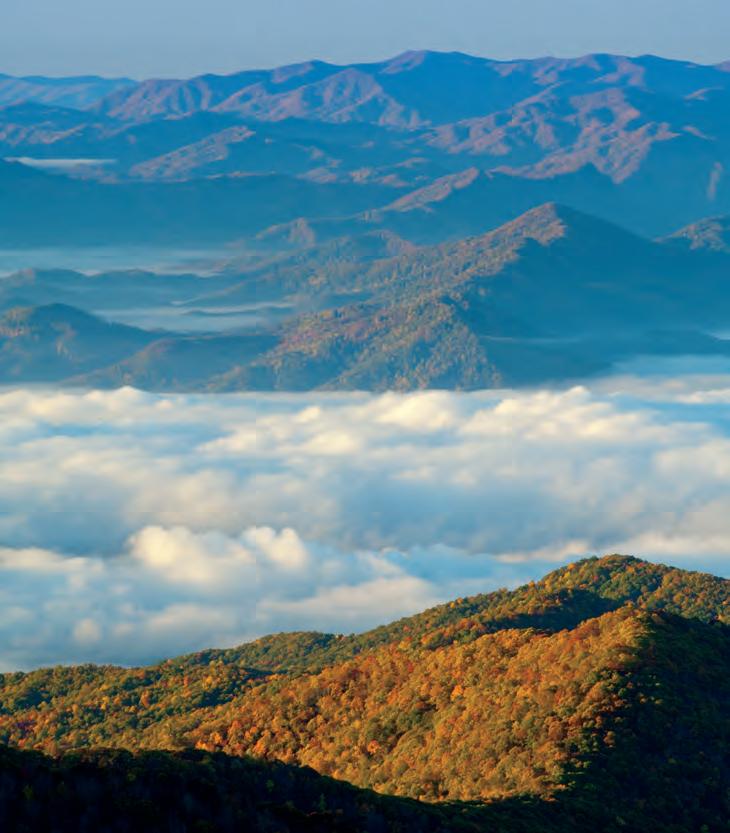
6 minute read
Christmas in Cades Cove
in winter. Bears are in their winter dens, most birds have migrated south, and for the early settlers in Cades Cove, it was often a lean time. With little food available from the woods, they had to rely on what they’d cultivated in their gardens and the pork they’d preserved with salt and smoke. Around 1818, when John Oliver and his family moved into the Cove, they survived the winter only through the generosity of Cherokee Indians, who shared dried pumpkin and other foods with them.
Christmas celebrations were nearly nonexistent in this atmosphere of austerity. Church services were often canceled for the season because it was too difficult to travel, so families prayed at home. It was a day of quiet reflection—if anything was given, it was “good deeds and good thoughts” not treats and presents. While folks in Cades Cove generally celebrated Christmas on December 25th, in some pockets of the mountains, old timers grew up observing “Old Christmas” on January 6th, the date of Jesus’s birth according to the Julian (old style) calendar.
As the Cove grew and flourished—with more families, more churches and schools, and more connections to places outside the mountains—hints of our
The John Oliver cabin on the Cades Cove Loop Road is one of the oldest historic homes in the park. It was built in the 1820s by John and Lucretia Oliver and remained in the family up until park establishment in the 1930s. The large stone chimney is held together with mortar made from mud and other materials.
PHOTOGRAPH BY BILL LEA
modern Christmas celebrations began to appear. Judge William W. Oliver (great-great-grandson of the original settler John Oliver,) whose childhood spanned the 1910s and ‘20s recalls the serenades and other fond Christmas memories briefly in his memoir, Cades Cove: A Personal History: “Christmas was a joyous time. For many years after we moved to the lower end of the Cove, I recall the Christmas Eve serenades. A group of men and boys went to each house in the neighborhood, and would run around the house several times ringing cow bells, shooting shotguns and firecrackers and blowing horns. They were then treated with apples or candy...
A couple of weeks before Christmas, my mother would make a list and send me to the store, and instructed me to hide all those Christmas treats in the loft of the old barn.... Christmas Eve, after all the other children had gone to bed, Santa Claus filled the stockings with the goodies from Uncle Russ’s store. They were all up before daylight the next morning to see what Santa had brought.” Other families had boxes with abundant candy and treats around for these “serenaders” as well. After the ruckus had quieted down, the visitors would often be invited in for a Christmas treat, usually candy or nuts. On Christmas day, anyone could be entitled to a treat if he or she was the first to shout, “Christmas give!” or sometimes “Christmas gift!” when greeting a neighbor or family member.
Throughout most of the year, R.D. and Mary Jane Burchfield’s store on Forge Creek Road in the bustling Cades Cove community stocked practical inventory: farm equipment, flour and coffee, bolts of cloth. But as Christmas time approached in December, the counters of the modest woodframe store—operated in the 1920s and early ‘30s—were adorned with fancy candies and exotic, colorful fruits like bananas and oranges. Most of the children who grew up in Cades Cove received these tropical fruits and sweets as presents, with fond memories of discovering the joys of a simple orange on Christmas morning.
As Santa became a common fixture in American
Christmas mythology throughout the 1800s and early 1900s, his legend reached the mountain children too, largely through the influence of public schools. William Oliver attended the New Consolidated School, which opened in 1916. The school term ran from July 1 to Christmas, giving everyone an opportunity to celebrate the end of the term with a big Christmas party. “Yes, there was always a program at school, and a tree,” Inez Adams, a Cades Cove native says. The schools played a large role in bringing Christmas celebrations to the mountains—Oliver recalled in his memoir that the end-of-year festivities included decorating a school Christmas tree and a visit from Santa Claus. One year, William Oliver received a book of stories called Santa Claus at Sea, for best behavior in school. Christmas trees slowly became a common part of Smoky Mountain celebrations as well. With such lovely white pine, red cedar, and eastern hemlock trees in the woods around their homes, how could families resist? Fathers, sons, and sometimes the entire family would venture out into the cold to find “the perfect tree.” Traditionally, the trees were decorated with strings of popcorn and dried cranberries. Most cabins didn’t have electricity, so of course there were no electric lights. Inez Adams, whose family retained a special lease on their land in Cades Cove after the park was established, also remembers her grandmother making the most beautiful wreaths out of ground pine and holly berries, “just things she could get in the woods, and it was so beautiful.”
Even with trees, treats, hymns and prayers, Larry Sparks and Ruth Davis, whose families had extended leases similar to Inez’s, both remember that Christmas was by and large just another day. The mountain farms required constant attention, and in the cold of winter, Christmas was no exception. Cows had to be milked and fed. Hogs and horses had to be fed. Hens had to be looked after and eggs had to be collected before they froze and burst. Boys often laid traplines for muskrats and other critters in winter; those had to be checked. “We didn’t have much Christmas in Cades Cove,” Inez Adams says with a laugh.
But after the chores were done, families would gather together, making the journey across the Cove for a good Christmas meal. Pork tenderloin was often the main dish. Alongside would be fruits and vegetables that had been “put up” from the summer and fall harvest: sulfured apples, dried green beans (leather britches), stack cake, egg pie, and rich, creamy buttermilk.
On Christmas day, after enjoying a few sticks of special Christmas candy and perhaps playing a game or two of checkers, as Larry Sparks remembers, the kids would go to bed. Ruth Davis recalls that it was often so cold, and the bed was so heavy with her mother’s handmade quilts, that it was hard to turn over once you got in bed. “You made a warm place and didn’t move,” she remembered. Then morning would come and then, as now, Christmas would be 364 days away. v
Author Courtney Lix grew up in the Great Smoky Mountains and is the granddaughter of Henry Lix, a long-time ranger in the division of interpretation. Her writing awards include the Ferris Prize for Journalism from Princeton University, and the Gregory T. Pope Prize for Science Writing.
Top: The first Cades Cove Missionary Baptist Church was a log building constructed in 1832 near the present structure. The small congregation’s second “meeting house” was built in 1894, also in the same “Hyatt Hill” vicinity. The church we see today was constructed in 1915 and the congregation remained active through 1944. For many of its latter years, a Civilian Conservation Corps (CCC) camp was situated nearby and park visitors streamed by on Sundays in their automobiles. Bottom: Winter’s dustings of snow and frost make the small valley that is Cades Cove even more breathtakingly beautiful.

PHOTOGRAPH BY BILL LEA

PHOTOGRAPH BY BILL LEA






